
Fucus vesiculosus, known by the common names bladderwrack, black tang, rockweed, sea grapes, bladder fucus, sea oak, cut weed, dyers fucus, red fucus and rock wrack, is a seaweed found on the coasts of the North Sea, the western Baltic Sea and the Atlantic and Pacific Oceans. It was the original source of iodine, discovered in 1811, and was used extensively to treat goitre, a swelling of the thyroid gland related to iodine deficiency.
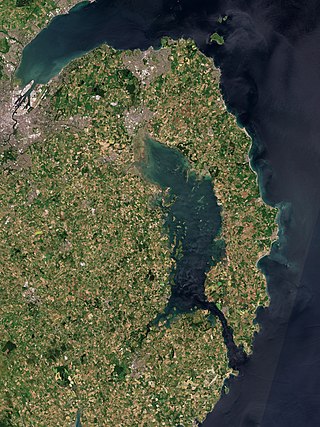
Strangford Lough is a large sea lough or inlet in County Down, in the east of Northern Ireland. It is the largest inlet in Ireland and the wider British Isles, covering 150 km2 (58 sq mi). The lough is almost fully enclosed by the Ards Peninsula and is linked to the Irish Sea by a long narrow channel at its southeastern edge. The main body of the lough has at least seventy islands along with many islets (pladdies), bays, coves, headlands and mudflats. It is part of the Strangford and Lecale Area of Outstanding Natural Beauty. Strangford Lough was designated as Northern Ireland's first Marine Conservation Zone in 2013, and has been designated a Special Area of Conservation for its important wildlife.

Fucus is a genus of brown algae found in the intertidal zones of rocky seashores almost throughout the world.
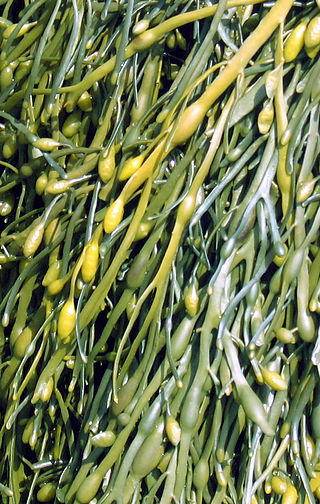
Ascophyllum nodosum is a large, common cold water seaweed or brown alga (Phaeophyceae) in the family Fucaceae. Its common names include knotted wrack, egg wrack, feamainn bhuí, rockweed, knotted kelp and Norwegian kelp. It grows only in the northern Atlantic Ocean, along the north-western coast of Europe including east Greenland and the north-eastern coast of North America. Its range further south of these latitudes is limited by warmer ocean waters. It dominates the intertidal zone. Ascophyllum nodosum has been used numerous times in scientific research and has even been found to benefit humans through consumption.

Fucus serratus is a seaweed of the north Atlantic Ocean, known as toothed wrack, serrated wrack, or saw rack.

Wrack is part of the common names of several species of seaweed in the family Fucaceae. It may also refer more generally to any seaweeds or seagrasses that wash up on beaches and may accumulate in the wrack zone.
Elsie May Burrows was an English botanist who made significant contributions to British postwar phycology. Her primary area of research was macroalgal ecology, focusing particularly on Fucus, a genus of brown algae, and Chlorophyta, a division of the green algae.

The Ballantine scale is a biologically defined scale for measuring the degree of exposure level of wave action on a rocky shore. Devised in 1961 by W. J. Ballantine, then at the zoology department of Queen Mary College, London, the scale is based on the observation that where shoreline species are concerned "Different species growing on rocky shores require different degrees of protection from certain aspects of the physical environment, of which wave action is often the most important." The species present in the littoral zone therefore indicate the degree of the shore's exposure.

Semibalanus balanoides is a common and widespread boreo-arctic species of acorn barnacle. It is common on rocks and other substrates in the intertidal zone of north-western Europe and both coasts of North America.

Saltern Cove is a Site of Special Scientific Interest. It is on the coast of Tor Bay, south of Paignton, Devon, England. It is one of the coves which make up the local area known as "Three Beaches".
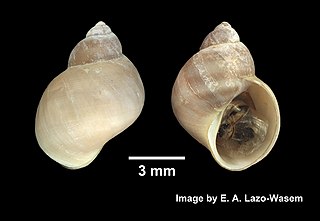
Lacuna vincta, commonly known as northern lacuna, wide lacuna, northern chink shell, or banded chink shell, is a species of sea snail, a marine gastropod mollusk in the family Littorinidae, the winkles or periwinkles. It is found intertidally and in shallow waters in both the northern Atlantic Ocean and the northern Pacific Ocean. It is a herbivore, feeding on seaweed and diatoms with its toothed radula.

Littorina fabalis is a species of sea snail, a marine gastropod mollusk in the family Littorinidae, the winkles or periwinkles.
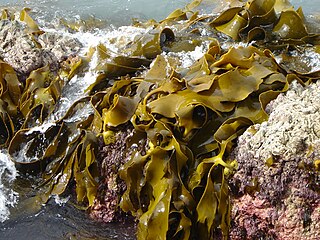
Phlorotannins are a type of tannins found in brown algae such as kelps and rockweeds or sargassacean species, and in a lower amount also in some red algae. Contrary to hydrolysable or condensed tannins, these compounds are oligomers of phloroglucinol (polyphloroglucinols). As they are called tannins, they have the ability to precipitate proteins. It has been noticed that some phlorotannins have the ability to oxidize and form covalent bonds with some proteins. In contrast, under similar experimental conditions three types of terrestrial tannins apparently did not form covalent complexes with proteins.
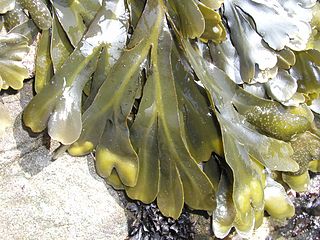
Fucus gardneri is a species of seaweed, a brown alga living on the littoral shore of the Pacific coasts of North America. It has the common names of rockweed and bladderwrack.
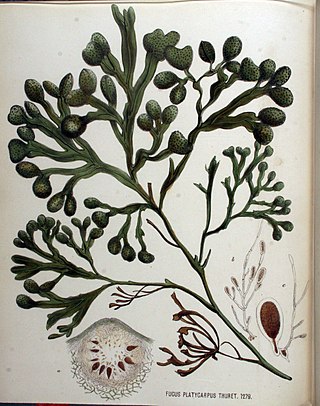
Fucus guiryi is a brown alga in the family Fucaceae. It is known from numerous locations along the east coast of the North Atlantic Ocean, from Ireland to the Canary Islands.
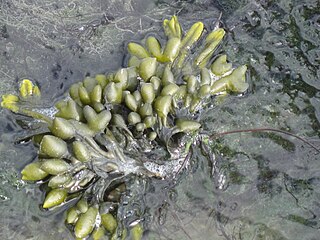
Fucus ceranoides is a species of brown algae found in the littoral zone of the sea shore.

Polysiphonia lanosa is a common species of the red algae (Rhodophyta) often to be found growing on Ascophyllum nodosum.
Fucus cottonii, also known as moss wrack, is a species of brown algae that grows in low energy salt-marsh environments on Atlantic and Pacific coasts. The algae is small in comparison to other members of the Fucus genus and lacks the bladders common in other species, such as Fucus vesiculosus. The species either grows partially embedded in the banks of an estuary, or entangled in halophytic vegetation.
















